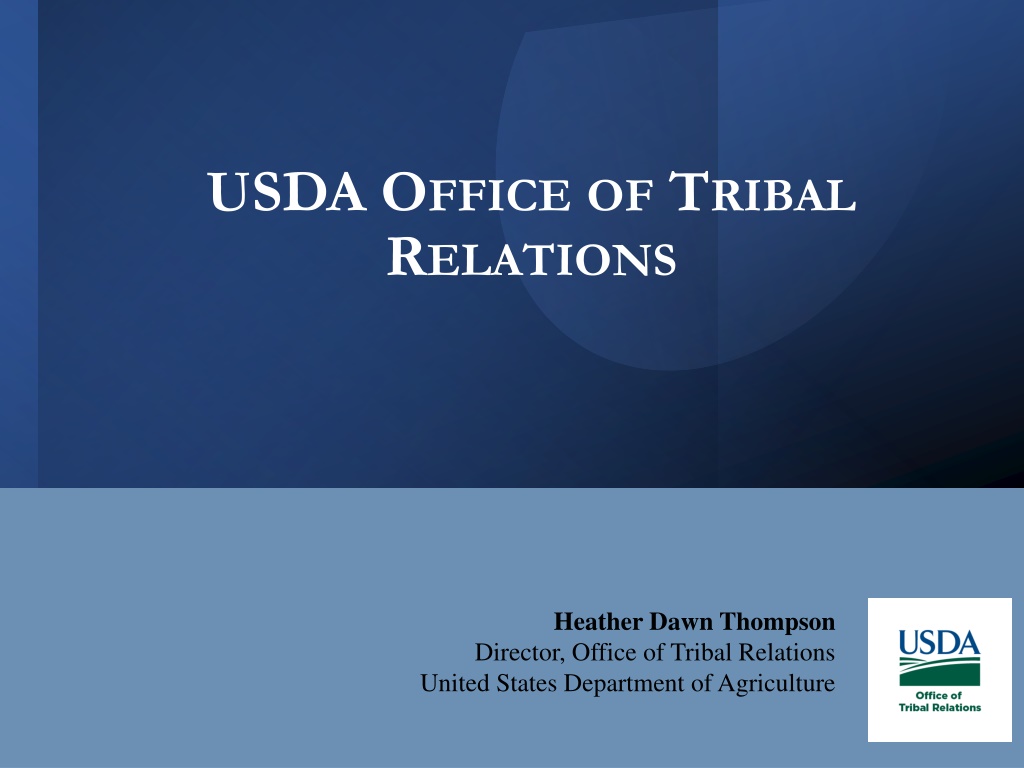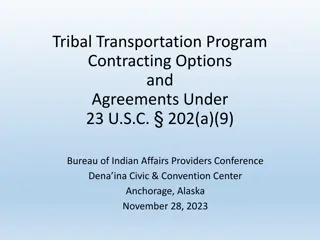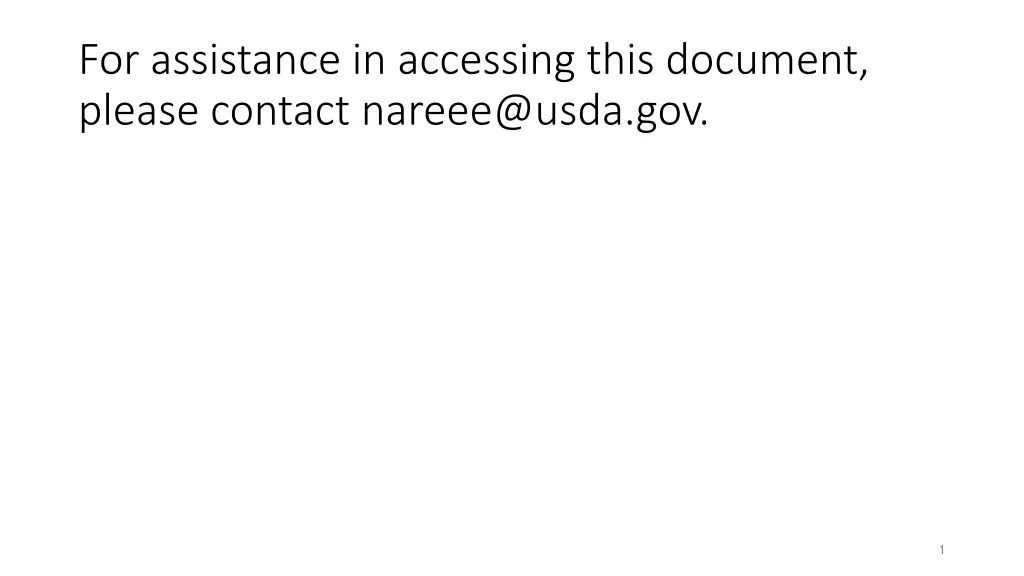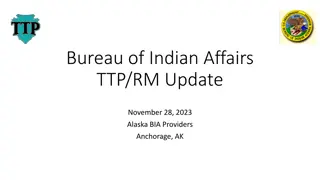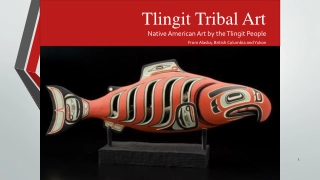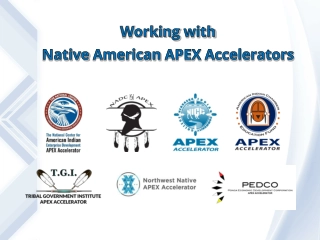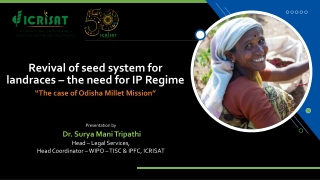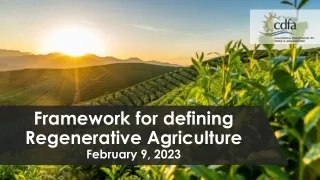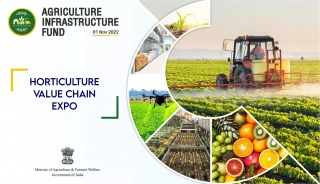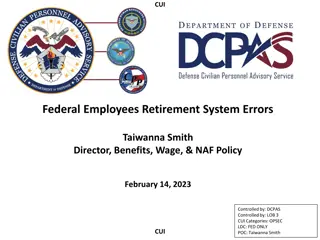USDA Tribal Relations and Federal Policy in Native Agriculture
Explore the role of the USDA Office of Tribal Relations and the USDA Tribal Advisory Committee in addressing barriers and federal policies impacting tribal agriculture. Learn about tribal eligibility, statutory requirements, and the historical eras of federal Indian policy affecting Native American communities.
Download Presentation
Please find below an Image/Link to download the presentation.
The content on the website is provided AS IS for your information and personal use only. It may not be sold, licensed, or shared on other websites without obtaining consent from the author. Download presentation by click this link. If you encounter any issues during the download, it is possible that the publisher has removed the file from their server.
Presentation Transcript
USDA OFFICEOF TRIBAL RELATIONS Heather Dawn Thompson Director, Office of Tribal Relations United States Department of Agriculture
I. USDA TRIBAL ADVISORY COMMITTEE (TAC)
USDA (3) Chair, Senate Indian Affairs (1) Ranking Member, Senate Indian Affairs (1) APPOINTED BY: Chair, Senate Agriculture (1) Ranking Member, Senate Agriculture (1) Chair, House Agriculture (2) Ranking Member, House Agriculture (2)
NOMINATORS: An Indian tribe An Tribal organization A national or regional organization with expertise tribal agriculture REQUIREMENTS: diverse set of expertise on issues relating to geographic regions, Indian tribes, and the agricultural industry
II. USDA TRIBAL BARRIERS ANNUAL CONSULTATION
Regulatory/Administrative Tribal land definitions/eligibility Tribal government and entity definitions/eligibility Eligibility of indigenous plants and animals Native language availability TRIBAL BARRIERS Statutory Matching requirements Requiring tribes to work through states
III. FEDERAL POLICY IMPACTON TRIBAL AGRICULTURE
FEDERAL POLICIESOF LAND LOSS
ERAS OF FEDERAL INDIAN POLICY Tribal Government Westernization War & Treaty Making Self- Determination 1800-1890s 1934 1945 1968 present 1887 1934 1945 1968 Assimilation & Land Allotment Tribal Termination
I. DESTRUCTION OF INDIGENOUS FOODWAYS (War) IMPACTOF FEDERAL INDIAN POLICY on TRIBAL FOOD & AGRICULTURE II. FORCEDADOPTION OF WESTERN FARMING (Assimilation) III. LACK OF LAND AND RESOURCES TO IMPLEMENT (Allotment) IV. CONTROL & PUNISHMENT (Assimilation & Allotment)
I. DESTRUCTION OF INDIGENOUS FOODWAYS (War) IMPACTOF FEDERAL INDIAN POLICY on TRIBAL FOOD & AGRICULTURE
IMPACTOF FEDERAL INDIAN POLICY on TRIBAL FOOD & AGRICULTURE II. FORCEDADOPTION OF WESTERN FARMING/FOOD (Assimilation)
BLACK HILLS TREATY Act of February 28, 1877 (19 Stat. 254) In consideration of the foregoing cession of territory and rights, and upon full compliance with each and every obligation assumed by the said Indians, the United States does agree to provide all necessary aid to assist the said Indians in the work of civilization; to furnish to them schools and instruction in mechanical and agricultural arts,as provided for by the treaty of 1868.
ARTICLE 5 - AGRICULTURE The Government will aid said Indians in finding a market for their surplus productions, and in finding employment, and will purchase such surplus, as far as may be required, for supplying food to those Indians, parties to this agreement, who are unable to sustain themselves; and will also employ Indians in the performance of Government work upon their reservation.
IMPACTOF FEDERAL INDIAN POLICY on TRIBAL FOOD & AGRICULTURE III. LACK OF LAND AND RESOURCES TO IMPLEMENT (Allotment)
IMPACTOF FEDERAL INDIAN POLICY on TRIBAL FOOD & AGRICULTURE IV. CONTROL & PUNISHMENT OVER FOOD/AG (Assimilation & Allotment)
ARTICLE 5 - AGRICULTURE "In consideration of the foregoing cession of territory and rights the United States does agree to provide the said Indians with subsistence consisting of a rations for each individual of a pound and a half of beef, (or in lieu thereof, one half pound of bacon,) one-half pound of flour, and one-half pound of corn; and for every one hundred rations, four pounds of coffee, eight pounds of sugar, and three pounds of beans, or in lieu of said articles the equivalent thereof . * Rations shall, in all cases, be issued to the head of each separate family; no rations shall be issued for children between the ages of six and fourteen years unless such children shall regularly attend school. Whenever the said Indians shall be located upon lands which are suitable for cultivation, rations shall be issued only to the persons and families of those persons who labor .
WHERE DOES THAT BRING US TODAY?
USDA PROGRAMS AMS: Mobile Meeting Processing/Field Harvest (Tribal Seafood; Future Meat Processing/Supply Chain Progams) FDPIR: Incorporating Indigenous Foods (salmon, bison, wild rice, Demonstration Project) USFS: Providing Access to Indigenous Plants & Animals (FS treaty rights, foraging policies) FPAC: Funding Indigenous Plants & Animals
Indigenous Foods Foraging Videos: UTTC s Linda Black Elk USDA Indigenous Foods Recipes & Cooking Videos: Sioux Chef s Sean Sherman INDIGENOUS FOOD SOVEREIGNTY INITIATIVE Domestic Marketing for Native American Producers: Intertribal Agriculture Council Indigenous Seed Processing Centers: Native American Food Sovereignty Alliance How To Manual: ITBC: Transitioning from Cattle to Bison Ranching
QUESTIONS? Heather Dawn Thompson Director, Office of Tribal Relations United States Department of Agriculture
